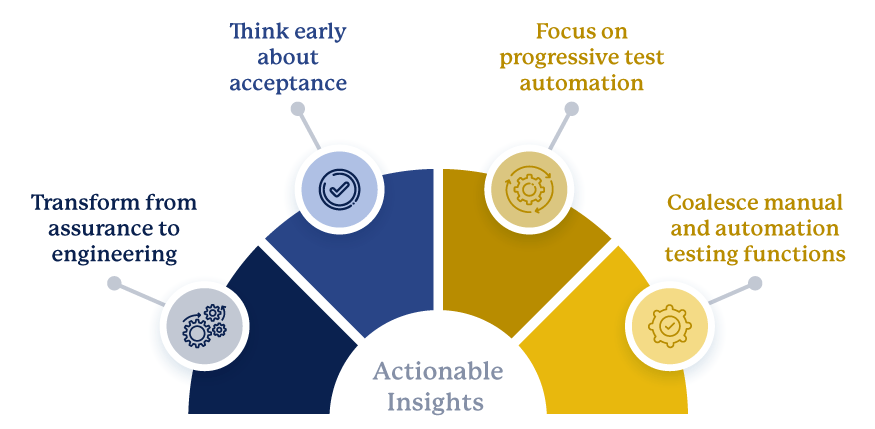

Client
A leading U.S. brokerage firm with $1+ trillion in assets and serving 6,000+ RIAs
Goal
Resolve online platform accessibility, functionality and timeliness issues
Tools and Technologies
Angular 9, Jenkins, Pivotal Cloud Foundry, Oracle, Kubernetes, Spring, Docker
Business Challenge
Client’s existing brokerage platform supporting over 6,000 Registered Investment Advisors (RIAs) and containing information about assets valued at more than $1 trillion had accessibility issues. The high cost of owning and maintaining outdated technologies and time-to-market for new features were adding to the business challenges.

Solution
Iris transitioned the client’s monolith applications to microservices to transform the RIA platform. An open-source, cloud technical stack was leveraged to develop a single-page, micro-UI-based application. BFF (Backend for Frontend) design was applied, and Angular 9 was used to achieve superior compatibility on mobile devices.
Widgets were introduced to enable seamless transitions within third-party applications. Consolidated user views were created to track assets and their performance for a unified experience for the RIAs.

Outcomes
The RIA platform transformation enabled the client to achieve significant functional enhancements, including:
- Fully functional mobile views
- 100+ integrated third-party applications
- Instant and seamless access to client accounts
- Downtime for hot deployments of fixes brought to zero
- Technical debt decreased by 45%
- Release timelines shortened by 80%
- Issue resolution time reduced by 90%

Our experts can help you find the right solutions to meet your needs.
Cloud data lakehouse for single source of truth



Client
A medical devices and fertility solutions company
Goal
Establish a cloud data warehouse for a single source of truth and timely month-end activities
Tools and Technologies
Azure Data Factory, Azure Data Lake, Power BI, Synapse Analytics
Business Challenge
The client had multiple instances of ERPs, sales systems, and warehouses built on obsolete technology and frameworks. The existing system siloed the data, resulting in inconsistent versions of the truth. The client's finance and sales teams were struggling to reconcile data offline and feed the same back into the ERPs, causing significant delays in month-end activities.
As the record systems were also not synced and legacy reports were built on the interim warehouses, line managers and executive teams were not able to extract actionable and comprehensive insights. A solution to onboard and integrate new datasets on an ongoing basis was required to support the data merger and acquisition process.

Solution
A strategy to transform data and BI applications to MS Azure was finalized. The transformation was executed in phases and included discovery, report rationalization and foundational build of a global system of reporting.
The solution included the data ingestion process with Azure Data Factory, data storage and processing using Azure Data Lake and Synapse Analytics, reports and dashboards with Power BI.
A utility to accelerate the onboarding of new data entities was conceptualized and delivered to onboard and integrate new datasets to support mergers and acquisitions.

Outcomes
Iris data practitioners helped the client overcome key challenges and advanced data warehousing capabilities by:
- Establishing a "single version of the truth" that enabled data-driven decisions and timely completion of month-end and other critical activities
- Delivering analytics for “Order to Cash” processes, including subject areas of sales, inventory, shipping, finance, etc.
- Facilitating the generation of actionable, insightful reports and dashboards, allowing "self-service" consumption for the business leadership

Our experts can help you find the right solutions to meet your needs.
Tech stack automation expedites development by 3x



Client
A leading building supplies manufacturing company
Goal
To support 30+ applications stack for UI, E2E, APIs, performance, mobile automation along with DevOps pipeline integration
Tools and Technologies
.NET Core, PeopleSoft, Salesforce, WMS, JavaScript, Angular, Foxpro, C#, Selenium, SpecFlow, RestSharp, Nunit, Mobile Center/Emulators, Allure, Jira, Azure Pipeline, GitHub
Business Challenge
The client had technology stacks comprising of diverse technologies that were difficult to manage. Substantial manual effort and time were spent on integrating the checkpoints, elongating the development process. Validating end-to-end business flows across different applications was the prime challenge. Reporting processes were also scattered across the entire application stack, making it vulnerable.

Solution
Iris developed a robust application agnostic Test Automation framework to support the client’s multiple-technology stacks. Following the Behavior-driven Development (BDD) approach to align the acceptance criteria with the stakeholders, we built business and application layers of the common utilities in the core framework.
Our experts identified E2E business flows to validate the downstream impact of the change and automated the entire stack through the shift-left approach. Azure DevOps integration enabled a common dashboard for reporting. The client attained complete version control to track production health and enforce strong validations.

Outcomes
Iris Automation solution enabled the client to surpass several business goals. The key outcomes of the delivered solution included:
- ~65% Increase in automation coverage
- 100+ Pipelines for in-scope applications across multiple environments
- 3700+ Test Automation scripts execution per sprint cycle achieved across applications
- 3X Faster script development of behavior-driven test cases
- Multi-day manual test effort reduced to a few hours of automated regression
- 70% Reduction in effort

Our experts can help you find the right solutions to meet your needs.
Digital ledger secures trading integrity



Client
Global bank's trading operations
Goal
Resolve trading transaction breaks and related regulatory issues through expandable intra-company digital ledger system
Tools and Technologies
Hyperledger Fabric 1.4/2.2, Java 8, Go Language 1.8, Kafka, Node JS, Microservices, OpenShift, Dockers, Kubernetes
Business Challenge
A highly-manual, paper-dependent, trading and reconciliation process was causing the accumulation of a large number of daily transaction liquidity breaks, which had been cited by federal regulators and risked a billion dollar cost impact.
The lack of a robust trade audit and reconciliation process to reduce liquidity breaks and operating costs led the bank to seek an immutable system that could record and unify financial practices and be expanded to other transaction areas.

Solution
Iris solution comprised a production-ready, configurable platform using microservices and blockchain-based digital ledger architecture. It employed Smart Contracts coded with requisite business rules to facilitate front office trade booking and trade reconciliation processes.
RPA was utilized to automate data mapping and testing of transactions. Preventive controls were enabled by recording intra-company transactions at their initiation using uniform booking practices, and consequently guaranteeing the term of the trade. A multi-layered infrastructure was created to support real-time, batch streaming of differing file formats. The UX was enriched through Interactive UI and automated workflows.

Outcomes
Iris successfully introduced a global intra-company distributed ledger and trade reconciliation system that did not exist before. With self-executing contracts matching both sides of transactions prior to feeding downstream systems, the platform ensures complete integrity at the source and reduces time and cost for all transactions. The solution also achieved:
- 30% fewer liquidity breaks
- 70% improvement in operational efficiency due to the use of RPA
- 60% reduction in business-rules configuration time, due to the smart contracts

Our experts can help you find the right solutions to meet your needs.
Software transformation gets compliance for bank


Risk & Compliance
Software transformation gets FDIC compliance for bank

Client
A global investment bank
Goal
To have a unified functional validation system for FDIC compliance
Tools and Technologies
SQL Server, Sybase, Data Lake, UTM, .NET, DTA, Control-M, ALM, JIRA, Git, RLM, Nexus, Unix, WinSCP, Putty, Python, PyCharm, Confluence, Rabacus, SNS, and Datawatch
Business Challenge
The client mandated to comply with new QFC (Qualified Financial Contracts) regulations. The client also needed to perform in-depth functional validation across a revamped data platform to ensure it could timely process, review and submit to the FDIC (Federal Deposit Insurance Corp.) required daily reports on the open QFC positions of all its counterparties.
The project entailed immediate availability and processing of accurate QFC information at the close of each business day to swiftly assess data and note exceptions and exclusions for early corrective action. It also aimed to help the client meet stringent deadlines with varied report formats. Any breach or delay in compliance could attach hefty fines and reputational damage to the bank.

Solution
Iris revamped the entire system and performed end-to-end quality assurance and testing across the new regulatory reporting platform. This meant validating the transformed multi-layer database, user interface (UI), business process rules, and downstream applications.
We identified and solved workflow design gaps affecting data reporting on all open positions, agreements, margins, collaterals, and corporate entities, thus enhancing the capability for addressing irregularities. Our experts established an integrated and collaborative system, commanding transaction and reference data within a single platform by incorporating 166 distinct controls pertaining to data completeness, accuracy, consistency, and timeliness within a strategic framework.

Outcomes
Our quality assurance and testing solution delivered the following impacts:
- Faster and more efficient internal analysis with highly accurate QFC open positions
- 100% compliance with timing and format of required daily QFC report submissions to the FDIC
- Significant decrease in exceptions before the platform went go-live and critical defect delivery drastically reduced post-implementation
- An intuitive UI dashboard reflecting the real-time status of critical underlying data volumes, leakages, job run, and other stats

Our experts can help you find the right solutions to meet your needs.
Platform re-engineering for operational efficiency



Client
One of the top 20 brokerage banks in North America
Goal
Modernize an existing, licensed data platform to meet the increasing volume of transactions and product offerings
Tools and Technologies
Python, Core Java, Oracle, ETL Framework, Apache Zookeeper, Anaconda, Maven, Bamboo, Sonar, Bitbucket
Business Challenge
The client had a licensed data platform for enterprise-wide risk and compliance operations. Spiked volumes with various financial product offerings and trades were restricting the processes and limiting the analytical capabilities on the existing platform.
The system upgrade was required to support related, complex credit risk calculations. These calculations serve as a ground for several thousand bankers/ traders to make loan and investment decisions for customers. System modernization would also cater to the internal transaction and regulatory reporting requirements.

Solution
Iris system re-engineering experts designed and implemented a scalable and highly configurable data extraction platform having global data architecture. This ETL framework-based platform enables faster, more efficient onboarding, consolidation, and processing of the numerous variable product and trading data input sources.
The re-engineered platform was enabled with value-adds and tools to automate, tabulate, compare, reserve, validate and test data. We integrated the data extraction platform seamlessly with downstream risk applications and system adaptability to accommodate operational/business needs.

Outcomes
Our data platform re-engineering solution enabled the client to achieve enormous benefits, including user experience, data quality, and risk management capabilities. Key outcomes of the solution constitute:
- Quicker, real-time configuration and execution of 500+ jobs for loading trade feed
- Downtime reduced to a minimum even during the trade reference data changes
- 15% faster onboarding of the new feed or data source
- Nearly 20% faster throughput for various critical feeds with parallel processing feature
- Reduced anomalies and duplication with improved consistency
- 35-40% savings in annual third-party platform/ module license fees
- Standardized and streamlined onboarding processes and turnaround time, scaling the operational efficiencies

Our experts can help you find the right solutions to meet your needs.
IT modernization boosts Insurance customer base



Client
A leading American Fortune 500 Insurance Services Provider, offering insurance, investment management and financial products & services across the Americas and 40 other countries
Goal
To advance business agility and customer experience through modernized business systems
Tools and Technologies
C#/.NET, JAVA, DevOps, Python, NodeJS, App Services, Managed Application Support
Business Challenge
The client’s existing business applications, systems, and support services were in stasis and not delivering the much-needed value to the insurer and end customers.
Due to the lack of enterprise application portfolio strategy, business functions were onboarding applications in a silo. The net impact was that the insurer’s revenue and market share decreased.
Longer turnaround times and outdated UI were discouraging customers. On the other hand, prospective customers were also opting for modernized options available in the market.

Solution
Iris delivered app development and managed services across Annuities, Life Insurance, Group Insurance, Retirements and the Global Enterprise Service groups that decide the platform for all business units. Our services spanned around Enterprise Collaboration portal, Financial Wellness platform, Mutual Fund platform modernization, Oracle EBS development and support, and Retirement Annuities platform management.
We also executed a scaled Agile program and ran multiple Scrums within the enterprise development and support landscape. Iris tech experts established DevOps and scaled Agile Framework within the client organization and enabled a team of over 150 professionals globally to support business operations 24X7.

Outcomes
Iris has been working around the application portfolio for over three years. We have helped the client deliver an exceptional experience to employees and end customers through active service support. Key outcomes of the delivered solution included:
- Infrastructure availability increased to 99%
- Optimized maintainability reduced the KYC process time by 75%
- Customer response time cut down by around 40%
- Promoter score incremented from 5 to 9 out of 10
- Customer retention improved by nearly 80%
- Customer acquisition increased by 65%

Our experts can help you find the right solutions to meet your needs.
SFTR solution strengthened market leadership


Risk & Compliance
Securities financing transactions regulation compliance made easy

Client
A leading provider of market data and trading services
Goal
Support complex regulatory reporting with automated solution
Tools and Technologies
Java, Spring Boot, Apache Camel, CXF, Drools BRE, Oracle, JBoss Fuse, Elasticsearch, Git, Bitbucket, Sonar, Maven
Business Challenge
The client offers an automated, integrated solution to its clients in the European Union (EU) for complying with the Securities Financing Transactions Regulation (SFTR).
Effective in recent years, SFTR requires timely and detailed reporting based on multitudes of data, systems, collateral, and lifecycle events. The voluminous data is captured from hundreds of millions of daily transactions made to multiple trade repositories registered by the European Securities and Markets Authorities (ESMA).
Non-compliance at any stage is risky, potentially very costly, for all trade counterparties, i.e., broker-dealers, banks, asset managers, institutional investors.

Solution
Experienced in diverse technologies, big data, and capital markets, team Iris developed a streamlined, end-to-end data reporting platform with complex trade matching and monitoring systems. Improving speed, accuracy, and flexibility, the new architecture supports high trade concurrency and acceptance rates with parallel processing of millions of transactions.
The delivered solution also enabled optimal load balancing and matched the reconciliation at the trade repository. Built with microservices to accommodate future scalability, standardization, data quality, and security requirements, the system implemented functional enhancements. A Unique Transaction Identifier (UTI) subsystem was also developed for sharing and matching counterparty transactions, enabling plug-and-play setup for new repositories, and supporting any changes in outbound or inbound data report formats required by ESMA or clients. Improved dashboards and search pages helped the end-users in better configuration and tracking of their transactions.

Outcomes
The nimble delivery and successful roll-out of the new SFTR platform delivered the desired strategic competitive advantage to the client for maintaining its EU market leader position. The consolidated solution also helped in:
- Generating additional revenue from extending the new reporting services to 17 firms
- Beating the industry benchmark (~91%), achieving a higher transaction acceptance rate (~97%), and match reconciliation at the trade repository
- Supporting a high throughput of 6 million transactions per hour which is scalable up to 10 million

Our experts can help you find the right solutions to meet your needs.

Accelerate your agile software development
Businesses are increasingly using cloud technologies and service-oriented architectures to deliver their products and services on digital channels. They also want those IT solutions delivered increasingly faster. In order to meet those demands, IT has adopted Agile methodology to reduce time to develop new capabilities, apply fixes and deploy them to production.

The nature of software development is transforming with more frequent releases and monolithic architecture giving way to services. Consequently, there is a greater need to ensure that overall quality does not degrade in terms of usability, reliability, scalability and performance. Clearly, as application architecture is being modernized and software is being deployed expeditiously, this method of testing will not empower IT to deliver effectively. Practical experience has given us some actionable insights to shift approaches to quality in an Agile development environment.
Challenges
We find organizations frequently face the following key challenges in transforming their approach to Quality Engineering in an increasingly Agile enterprise:

Iris Solution
Iris solution combines using Acceptance Test Driven Development (ATDD) methodology to bring in the culture of early acceptance with continuous testing from development to production. This approach leverages DevOps and incorporates In-sprint Test Automation to accelerate between transition from a QA to a QE mindset. Our solution has a framework that enables these features:- Integration with tools that allow for developing a common understanding of requirements and specifications within the team
- Configuring a customer’s Agile development process (e.g., “Done” criteria) by integration with industry-standard tools that support code development, test scripts development and auto triggering of test execution, deployment and continuous monitoring
- Libraries with templates for gathering requirements and pre-built code for test execution, deployment and reporting
- A storehouse of reusable libraries that allow for quick access and updates of test scripts and easy integration of new components, thus reducing the maintenance burden
- A cross-referenced checklist to mark completion of all user stories, which is one of the most critical checkpoints in an Agile project
- A machine learning layer with baseline objects to support features such as self-healing and test analytics reporting. Using this facility, an Agile project can support automatic fixing of test scripts and test execution predictability, thus reducing the time and cost of custom development
Iris Automation Practice: Focus Areas and Competencies
Iris Automation Practice offers comprehensive services and solutions across competencies such as Intelligent Automation, Test Automation and DevOps Automation. Our approach introduces automation within the context of a function or industry to create seamless end-to-end processes and experiences. Our services, strengthened with machine learning and cognitive technologies, have stepped up productivity, resulting in immense benefits for our clients.Business Outcomes
- Our ATDD framework reduces the effort of building test automation suites by 30% and cuts maintenance costs by up to 60%
- Faster delivery cycles improve collaboration, thereby reducing total cycle time by 25%
- Reusability and modularity reduce efforts by up to 25%
- Increased coverage in regression test suite by 30-40%
Contact
Our experts can help you find the right solutions to meet your needs.
Get in touchCloud transformation increases business agility



Client
A non-profit global organization responsible for developing and maintaining standards, including barcodes with over 115 local member organizations and over 2 million user companies
Goals
To deliver MVPs in shorter cycles, reduce Mean Time for Ticket Resolution (MTTR), and lower the total cost of ownership
Tools and Technologies
C#/.NET Core, Python/DJango, NodeJS/Express, Azure WAF, Azure APIM, App Services, Azure Kubernetes Service, Azure Monitor, and Application Insights
Business Challenge
The client had a suite of legacy applications to generate barcodes that are scanned globally over 6 million times a day.
These applications were built on monolithic architectures using heavy-weight application servers and outdated technologies. This architecture was causing long development cycles, making the organization less competitive. Developers’ productivity was also dropping due to high technical debt.

Solution
Azure cloud offered some of the foundational features like container orchestration, app engine, integration, API gateway, monitoring and others, making cloud-specific modernization a natural choice.
Modernization strategy involved reverse engineering of on-premise applications, domain-specific grouping the product backlogs by, adopting domain-driven design, and using open source cloud-friendly software with CI/CD pipeline. We transformed the applications to a .NET core framework using cloud-native design principles on Azure cloud. The solution was developed using Azure App Services, front door and service bus following the agile development approach with two-week sprints.

Outcomes
- Reduction in Mean Time for Ticket Resolution (MTTR) by 30%
- Increase in application and infrastructure uptime to 99.9%
- Real-time visibility of application and infra metrics
- Enabled bi-weekly MVP delivery

Our experts can help you find the right solutions to meet your needs.
Industries
Company

Bring the future into focus.
